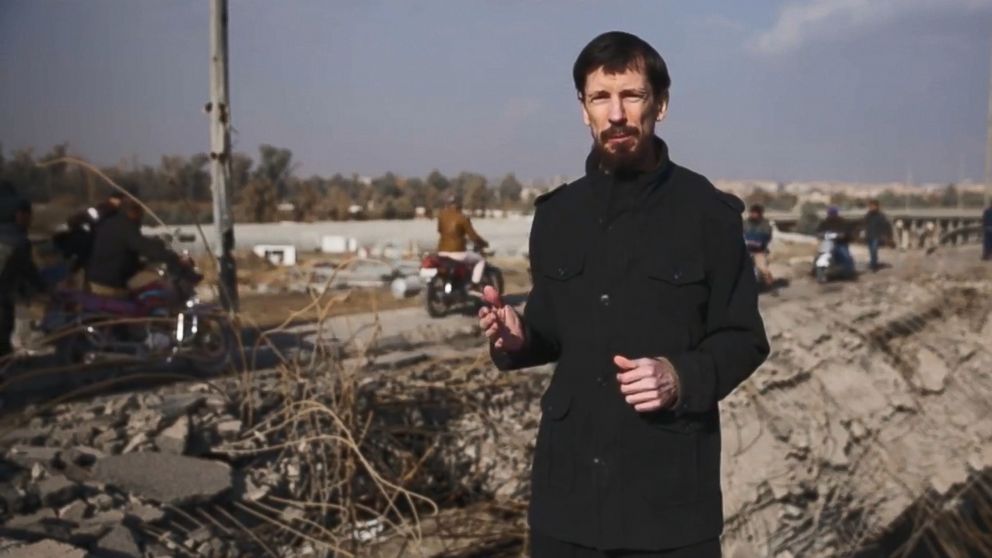UK Hostage John Cantlie in New ISIS Video Says Airstrikes Caused Mosul Suffering
Cantlie was last seen in July in a similar ISIS video.

— -- ISIS released a new, hastily produced video today using one of its last known western hostages – British journalist John Cantlie, who hasn't been seen since a video appearance five months ago – making coerced statements from the rubble of besieged Mosul, Iraq at the site of an apparent coalition airstrike.
The appearance of one of the last western hostages known to be held by ISIS, who was taken captive four years ago with American fellow journalist James Foley, brought reassurance that he is still alive.
Until the video today it has been unknown to the U.K. and American governments for months whether the captive remained alive, informed sources on both sides of the Atlantic have told ABC News.
Despite appearing in a dozen ISIS videos since 2014, including in embattled Syrian cities Aleppo and Kobani as well as Mosul, authorities consider him a hostage forced to play video correspondent for the terror group – appearing as if he is a soldier of the self-declared caliphate rather than a man clearly held against his will.
At London's Frontline Club, Cantlie's portrait hangs as a reminder of his uncertain fate as he faces his fellow war correspondents belly to the bar at the opposite end of the wood counter from a display of a half-dozen combat journalists' portraits who've been killed in the Middle East in recent years.
Cantlie's physical appearance has declined considerably since he first showed up on video two years into his captivity wearing an orange jumpsuit at a wood desk and reading ISIS-written anti-western statements on a TelePrompTer screen.
In the two-camera video released today, he appeared gaunt and haggard with cropped hair and a beard, dressed in a fashionable black coat, standing beside what remains of a bridge that was reportedly bombed.
His ISIS-crafted speech alleges that only civilians are being harmed by airstrikes targeting bridges and water pipes in Mosul over the Tigris River.
"Now, can't see any mujahideen, can you?" Cantlie says, shrugging and looking over his shoulder at the last intact bridge busy with traffic, and referring to the Arabic word for a fighter engaged in holy war. "No, these are just the everyday normal people of Mosul. The mujahideen are out on the front lines, kilometers outside."
On Tuesday, the U.S.-led coalition known as Operation Inherent Resolve said three airstrikes the day before had indeed destroyed "a land bridge; damaged a bridge, a front-end loader, 47 roads; and suppressed a tactical unit” in the city of Mosul – Iraq’s second-largest city, which is currently under siege by coalition and Iraqi military forces.
Those forces are trying to dislodge the terrorist fighters – estimated to number between 5,000-6,000 – and the terror group’s leader, Abu Bakr al-Baghdadi, from the city. Al-Baghdadi is suspected by senior U.S. military analysts to be hunkered down somewhere deep inside its teeming streets.
One top expert on hostage crises who once operated in the country said the video may be an effort to persuade the U.S. military that ISIS has left Mosul.
"What they're trying to say is ‘ISIS is gone, you're wasting your bullets and bombs. They're gone and the only people you're hurting is civilians.’” Chris Voss, former chief hostage negotiator for the FBI, including in Iraq, told ABC News. “The subtle messages are more effective."
Another message from ISIS seen by some government and private analysts in the 9-minute Cantlie video is that they still hold a few valuable hostages inside Mosul.
"It reminds me of how they used Cantlie in Kobani – a Western witness to the ruin rained down by Western fighter jets and an implicit threat that he and other hostages could be killed through indiscriminate bombing or ISIS reprisal," said William McCants, author of "The ISIS Apocalypse: The History, Strategy, and Doomsday Vision of the Islamic State."
Aaron Zelin, an expert on ISIS at the Washington Institute for Near-East Policy, said the strategy of using Cantlie to telegraph messages to the West may no longer be effective since the group "doesn't have the same kind of mystique as they did two years ago, not only with how they used social media but also the towns and cities they were taking. It's one thing to say 'we're expanding' but it's another to complain about bridges and water pipes being destroyed."




